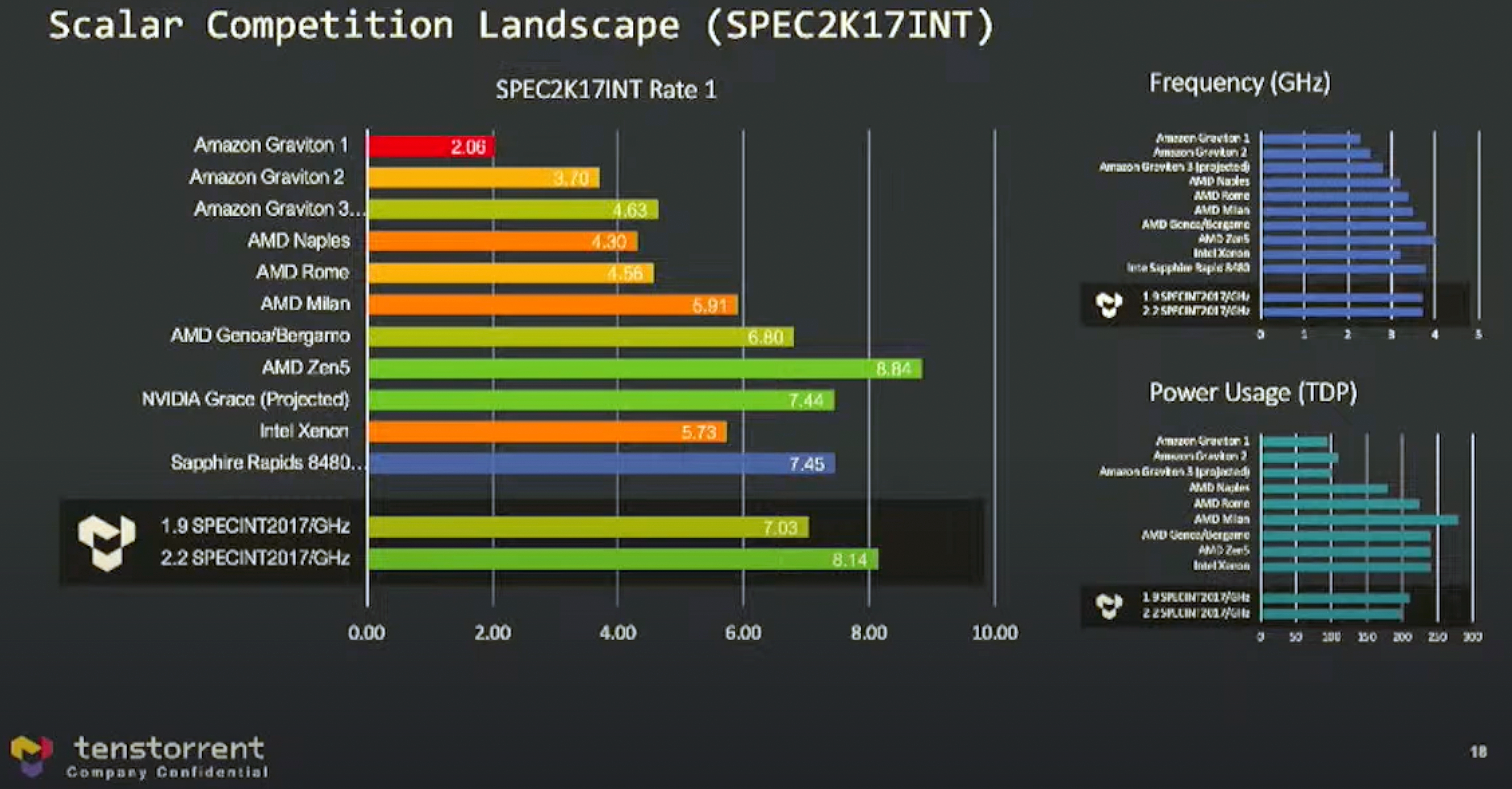Jim Keller Shares Zen 5 Performance Projections
AMD's Zen 5 could be integer performance champ, according to Tenstorrent.
Jim Keller, chief executive officer of Tenstorrent, shared the company's performance forecasts for CPUs based on its own Ascalon processor core compared to competitors, including AMD's Zen 5, Amazon's Graviton 3, and Nvidia's Grace. Tenstorrent's Ascalon is projected to provide market-leading integer performance-per-watt, but what attracted a lot of attention is that Tenstorrent expects AMD's Zen 5 to be the performance champion in raw integer throughput. In fact, Keller predicts that AMD's Zen 5 will be 30% faster than the current-gen Zen 4 in integer workloads.
Jim Keller shared the company's performance projections for Tenstorrent's in-house-designed 8-wide out-of-order execution Ascalon RISC-V core against potential competitors in the SPEC CPU 2017 INT Rate benchmark that measures integer performance. The company expects its Ascalon 1.9 SPEC2K17INT/GHz to hit 7.03 points and its Ascalon 2.2 SPEC2K17INT/GHz to hit 8.14 points.
Tenstorrent's performance expectations for its own CPUs were revealed at the Nerds Talking to Nerds About RISC-V event in India, as you can see in the slide below.
The predictions put Tenstorrent's upcoming CPU core comfortably ahead of Intel's Sapphire Rapids (7.45 points), Nvidia's Grace (7.44 points), and AMD's Zen 4 (6.80 points). Yet, AMD's Zen 5 is projected to hit 8.84 points, making it the absolute integer performance champion in 2024 – 2025.
There is a major catch with Tenstorrent's performance expectations: they are all projections and not real or even simulated benchmarks, Tenstorrent told Tom's Hardware. So while we can expect engineers from Tenstorrent to accurately model the performance of their own CPU design and try to predict what AMD could offer next, these are still projections, not actual benchmark results.
For obvious reasons, AMD's Zen 5 performance number has attracted the most attention, even though it is highly unlikely that this projection is completely accurate. But what is perhaps more important is that Tenstorrent expects AMD's Zen 5 to run north of 4.0 GHz and have a TDP south of 250W, as opposed to Ascalon running at around 3.80 GHz at a TDP of approximately 200W.
If power consumption is taken into account, it looks like processors based on Tenstorrent's Ascalon microarchitecture (such as the company's own Aegis chiplet) will indeed offer leading integer performance-per-watt, which is particularly important for the types of applications the processor is designed to satisfy.
Get Tom's Hardware's best news and in-depth reviews, straight to your inbox.

Anton Shilov is a contributing writer at Tom’s Hardware. Over the past couple of decades, he has covered everything from CPUs and GPUs to supercomputers and from modern process technologies and latest fab tools to high-tech industry trends.
-
hotaru.hino Reply
It's the most common data type that's operated upon in CPUs so... I think that's a huge deal.PlaneInTheSky said:"integer performance" is relevant to literally nothing -
JamesJones44 Replyhotaru.hino said:It's the most common data type that's operated upon in CPUs so... I think that's a huge deal.
Both forms are used pretty extensively these days. A lot of vectorized workflows, graphics and AI make extensive use of floating point based types. Which gets more use is strongly dependent on the use of the machine. Someone who does a lot of ML wouldn't benefit from great integer performance with subpar floating point performance for example. -
hotaru.hino Reply
Anything involving large scale compute will either be shoved onto GPUs or specialized processors anyway. I can only think of one supercomputer in the past decade that used only CPUs, and even then those CPUs were designed pretty much how a GPU would be designed. Everything else relied on GPUs to get their compute power (the current TOP500 computer has 4 GPUs per CPU, for instance)JamesJones44 said:Most things that do vectorization workflows use floating point, along with AI, graphics, etc. When I look at what is down the road in the future of computing, the biggest areas are floating point based.
A CPU is not useful as a data crunching part. You can shove more stuff onto it to do data crunching, but overall a CPU is useful for instruction crunching. -
ekio ReplyPlaneInTheSky said:"integer performance" is relevant to literally nothing
This comment is the most uneducated/idiotic of the day. -
ikjadoon Reply
Most workloads are integer-based. Geekbench is one of the few benchmarks that explicitly tests both and integer is given a much larger weighting. -
Nikolay Mihaylov Replyikjadoon said:Most workloads are integer-based.
True. But also, FP workloads are usually parallelizable either via vector processing or with more cores, maybe even on a GPU. And such tasks usually take longer and one expects them to take longer, rather than be done in a fraction of a second after the mouse click.
So this really is a big deal because it will increase the preceived responsiveness of the machine. -
bit_user Reply
So, like compiling code, web browsing, data compression, network stack, and OS performance are "literally nothing"? Not to mention most server apps involve mostly scalar, integer code: databases, web servers, video servers, etc.PlaneInTheSky said:"integer performance" is relevant to literally nothing
The SPECint 2017 suite, cited in the slide, is comprised of the following:
SPECrate®2017
IntegerSPECspeed®2017
IntegerLanguageKLOCApplication Area500.perlbench_r600.perlbench_sC 362Perl interpreter502.gcc_r 602.gcc_s C 1,304GNU C compiler505.mcf_r 605.mcf_s C 3Route planning520.omnetpp_r620.omnetpp_sC++ 134Discrete Event simulation - computer network523.xalancbmk_r623.xalancbmk_sC++ 520XML to HTML conversion via XSLT525.x264_r 625.x264_s C 96Video compression531.deepsjeng_r631.deepsjeng_sC++ 10Artificial Intelligence: alpha-beta tree search (Chess)541.leela_r 641.leela_s C++ 21Artificial Intelligence: Monte Carlo tree search (Go)548.exchange2_r648.exchange2_sFortran1Artificial Intelligence: recursive solution generator (Sudoku)557.xz_r 657.xz_s C 33General data compressionSource: https://www.spec.org/cpu2017/Docs/index.html#intspeed
Clearly, we see it also includes non-scalar workloads, such as x264 (a highly-optimized H.264 encoder). -
bit_user What I really came here to say: What the heck is Intel Xenon?Reply
Could it be some "skunk works" ARM core that Intel designed?
My other thought about this article: Good Luck! I sure hope their CPUs see the light of day in less time than the much-hyped Nuvia cores!
